There is a very pleasant riverside walk [1] along the Mole from Norbury Park through Leatherhead, which shows off a great deal of interesting history and wildlife.
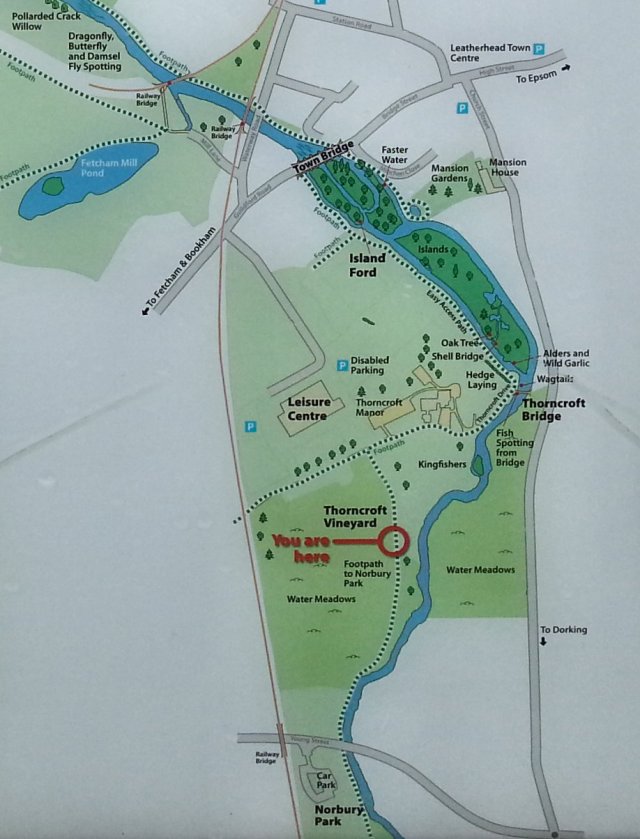
Riverside Walk Panel in Thorncroft Vineyard
Thorncroft Manor
The first stop after Norbury Park is Thorncroft farm, which is currently the base for Yum Cha Iced Teas, made with elderflowers and nettles, both of which grow in the vineyard by the river mole. The farm is owned by Guy Woodall, the inventor of “aerosol tea”:
Someone’s come up with aerosol tea and people are losing their minds
You can read a bit more about the annual elderflower harvest here.
The Manor House of Thorncroft was the residence of Mary Drinkwater Bethune, the author of the poem The River Mole, or Emlyn Stream discussed in a previous post. She writes:
“Yet wandering slowly on its gentle way,
Amid the sunny fields of Givon’s Grove,
Glittering between the tufted alder boughs,
Which cast their changing shadows on the stream,
The Mole steals softly now by Thorncroft’s meads.
Serene and silent, not a ripple plays
Upon its bosom, not a murmur tells
Its passing; but, like voiceless Time, it glides
Beneath the bridge and the o’erhanging screen
Of leafy boughs, where yonder timorous bird,
The golden-crested wren, has built her nest…” [2]
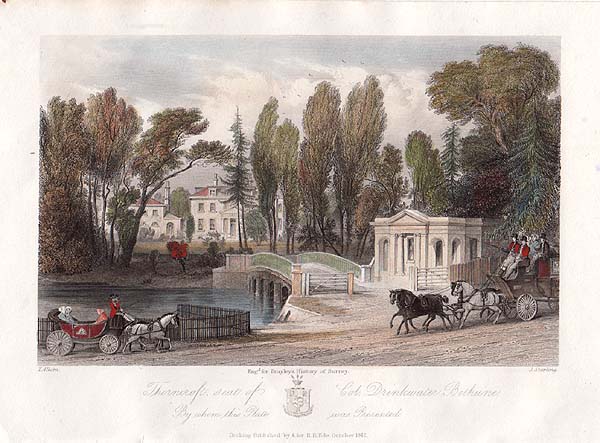
Thorncroft Manor in 1842, (image from http://www.antique-prints-maps.com)
Thorncroft Manor was one of the two feudal manors of Leatherhead from Norman times. It was held by Merton College, Oxford from 1266 to 1904. In his notes on Mary Bethune’s poem, Willam Cotton talks about the Manor house:
“The old Manor House of Thorncroft was built by Robert Gardyner, sergeant of the wine cellar to Queen Elizabeth, whose decease is recorded in a curious inscription written by Thomas Churchyard, the court poet, and engraved on a brass plate affixed to the wall in the south aisle of Leatherhead Church.
Thorncroft became afterwards the residence of Richard Dalton, Esq., sergeant of the wine cellar to King Charles II., and continued in his family for several descents. On the property falling into the possession of Henry Crab Boulton, Esq., he built, in 1772, a handsome new house on the site of the old timber-framed mansion, from a design by Sir Robert Taylor, architect of the Bank of England ; which was considerably enlarged afterwards by his nephew, the late H. Boulton, Esq.”
The house ceased to be a private residence during World War II when it was occupied by Canadian Soldiers. It is now the home of AGR Dynamics.
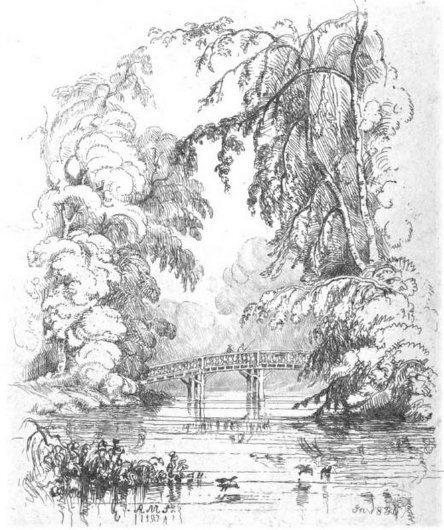
Thorncroft Bridge in 1824 (frontispiece to Mary Drinkwater Bethune’s “The River Mole or Emlyn Stream”)
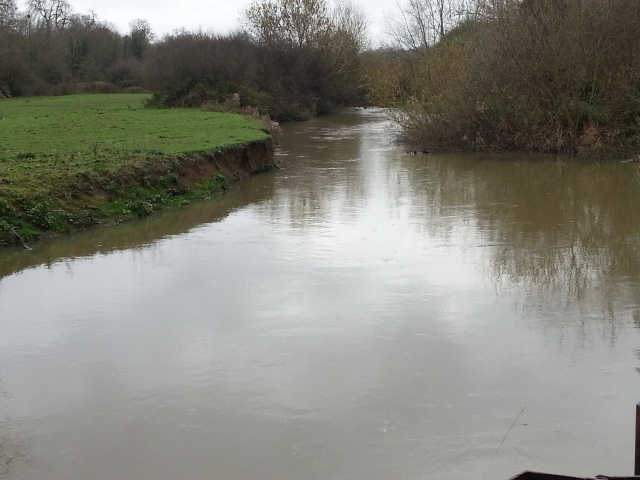
The view upriver from the present-day Thorncroft Bridge, with possible Kingfisher burrows.
Wildlife note: this part of the river Mole has places where the bank is eroded (as seen above), often on the outside of bends. Kingfishers love to nest in burrows dug into these sandy banks, and are relatively plentiful on this stretch of the Mole (I saw a kingfisher on two out of three walks in the area).
The Islands
Carrying on down towards the centre of Leatherhead, there are a number of islands in the river. Two are joined by the ‘shell bridge’ (so called because of the large shell ornamenting its keystone).
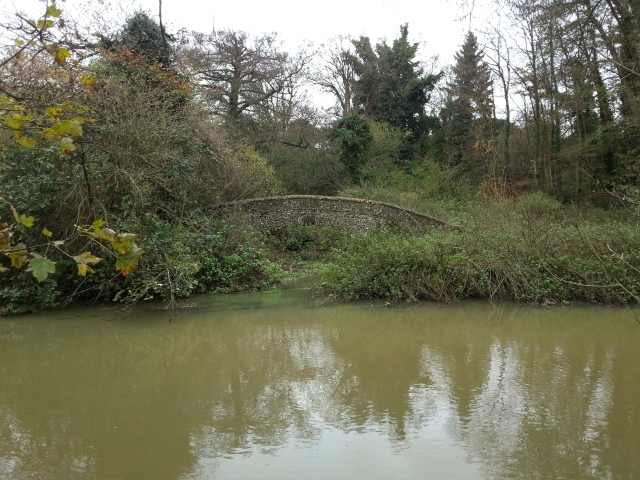
The Shell Bridge
Wildlife Note: As the shallow water runs over gravel it creates riffles (miniature rapids) where many fish species spawn.
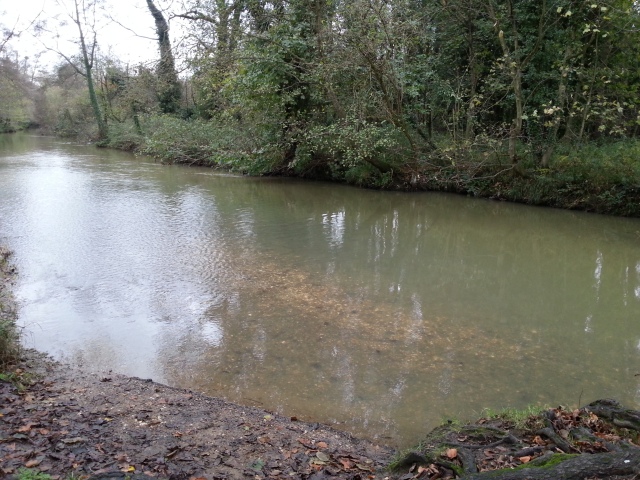
Riffles in the river
The islands near Thorncroft bridge are rich in Alder trees, and apparently give a wonderful display of wild garlic each spring (I will have to go back and visit in the springtime!). Otters would once have been plentiful on the river, but they are now out-competed by non-native minks. Efforts have been made to help otters re-establish on the river, and recently the Lower Mole Countryside Trust installed an Artificial Otter Holt on one of the islands by Thorncroft.
Notes:

Do you know anything about a bridge crossing next where the weir Behind the football club ? When the river is calm you can see what looks like 6x post coming from The river bed ? I once found some pictures which Looked like they where from the Victorian Times showing people sitting down having picnics on the island but can’t seem to find these pictures any more ? Just wondering was this how they got over to the island? The same island has 2x springs coming out of which flow in to the river which used to look blue in colour one of them flows from just past the shell bridge the other is further down and flows in to the opposite side I know this as I went over there in the early 1980s , just wondering if anyone had any photo evidence
Hi Lee – I don’t know, but maybe someone else will be able to help. Also you could ask your question on Facebook here: https://www.facebook.com/Leatherhead-District-Countryside-Protection-Society-185873041746273/
Rod
“wonderful display of wild garlic each spring”
There certainly has been in April/May 2024, especially where the river and path come close near Icehouse Combe. There’s also a good patch near the Stepping Stones.
Mary Bethune’s poem (which I hadn’t seen before) is spot on with:
“Serene and silent, not a ripple plays
Upon its bosom, not a murmur tells
Its passing..”
But beware! It’s deceptive. The sluggish flow on the surface belies a powerful current underneath, which has caught out many people, even strong swimmers. I’ve reviewed news cuttings over the past 100 years and found that the Mole takes a consistent toll of one life a year.
Curiously, in some places, the surface moves in the opposite direction to the main current, ie it appears to run upstream! And that’s not to mention its ability to disappear and reappear, which I witnessed and photographed during the Great Drought of August 1976. Walking along the bed from Leatherhead to Boxhill revealed just how uneven that bed is, and the differences in the bed material – doubtless another reason for the dangerous counter-currents.